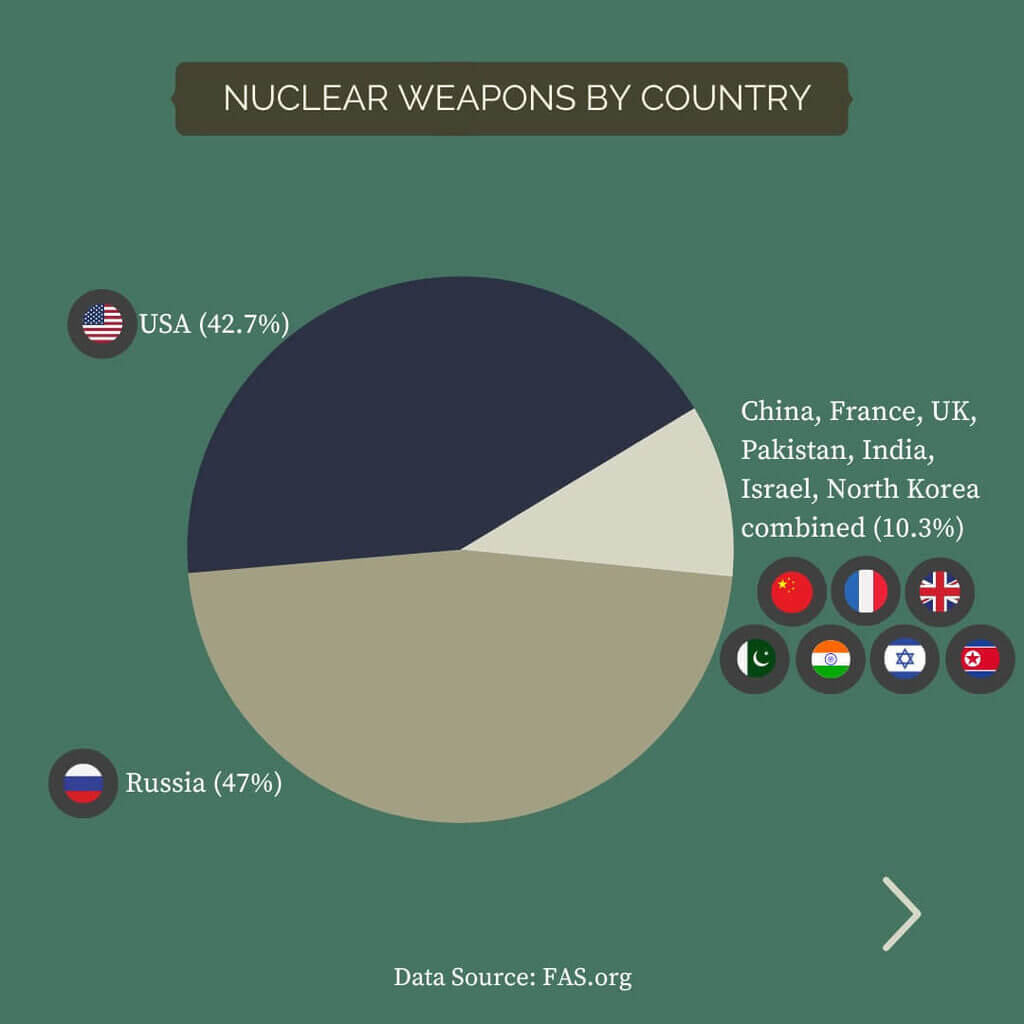
Russia’s Nuclear Weapons
Russia and Ukraine are the main parties in the conflict, with only Russia possessing nuclear weapons. While the exact numbers of nuclear weapons are unknown, estimates suggest that Russia has around 5,900 nuclear weapons while only about 1,500 are deployed. This means Russia has 1,500 nuclear weapons ready to use that are attached to intercontinental missiles or at military bases.
In March of 2023, President Putin announced that he would deploy nuclear weapons in Belarus. This is the only other country in which Russia has announced it will deploy nuclear arms to outside of its own borders. However, the Russian government has not yet moved nuclear weapons into Belarussian territory. Around 1,500 of Russia’s nuclear weapons are retired and are scheduled to be dismantled.
Ukraine’s Nuclear Weapons
While Ukraine does not currently possess nuclear weapons, it temporarily did in 1991. Ukraine inherited the approximately 5,000 nuclear weapons stationed on its territory after the collapse of the Soviet Union. This briefly gave Ukraine the third-largest nuclear arsenal in the world. However, in 1994, a series of trilateral talks between Ukraine, Russia, and the United States, called the Massandra Accords, concluded with Ukraine committing to complete disarmament in exchange for economic support and security assurances. Because dismantling nuclear infrastructure, missiles, and bombs was costly and the Ukrainian economy was shrinking at the time, the U.S. government agreed to provide economic aid for this in the Nunn-Lugar Cooperative Threat Reduction assistance. After receiving this aid, Ukraine began to transfer its nuclear weapons to Russia, a process that would be completed by 1996.
However, the Ukrainian government. feared that giving away its nuclear arms would compromise its national security. Thus, in 1994, Ukrainian President Leonid Kravchuk signed the Budapest Memorandum with Russia, the U.S., and the United Kingdom, which committed these countries to respect the sovereignty of Ukraine’s borders and refrain from threats of force against it. Later that year, Ukraine officially joined the Non-Proliferation Treaty, which advocates for preventing the spread of nuclear technology and weapons.
NATO’s Nuclear Weapons
Ukraine is not a member of NATO, the North Atlantic Treaty Organization (NATO), which is a military alliance with 32 member countries, including the US, France, and the U.K. NATO has not directly entered the Russia-Ukraine conflict, for example by sending troops or firing weapons from NATO territory. Still, most individual countries in NATO are indirectly involved in the conflict, for example, by transferring weapons or sharing intelligence.
NATO’s allies possess a combined total of roughly 6,000 nuclear weapons. The U.S. has the most nuclear weapons, at roughly 5,000, followed by France and the U.K. with arsenal’s each in the hundreds.
Like Russia, only a small portion of the U.S.’s nuclear weapons (approximately 1,6000) are deployed, meaning they are attached to delivery systems and ready for immediate use. The U.S.’s tactical nuclear weapons are currently deployed in six military bases in five NATO countries, Italy, the Netherlands, Turkey, Belgium, and Germany. Nearly all of France’s nuclear weapons are deployed on submarine-launched ballistic missiles. The U.K. has deployed half of its arsenal at sea and maintains the other half in reserve or storage.
Bibliographic Notes
Sources
- Bloomberg News. “Putin Says Russia to Place Tactical Nuclear Arms in Belarus.” Bloomberg.com, March 25, 2023. https://www.bloomberg.com/news/articles/2023-03-25/putin-says-russia-will-station-tactical-nuclear-arms-in-belarus?srnd=fixed-income
- Hans Kristensen, Matt Korda, Eliana Johns, and Kate Kohn. “Status of World Nuclear Forces.” Federation of American Scientists, June 22, 2023. https://fas.org/issues/nuclear-weapons/status-world-nuclear-forces/
- Jonathan Masters and Will Merrow, Jonathan. “Nuclear Weapons in Europe: Mapping U.S. and Russian Deployments.” Council on Foreign Relations, March 30, 2023. https://www.cfr.org/in-brief/nuclear-weapons-europe-mapping-us-and-russian-deployments#:~:text=The%20weapons%20were%20first%20transferred,%2C%20the%20Netherlands%2C%20and%20Turkey
- Liviu Horovitz, and Lydia Wachs. “France’s Nuclear Weapons and Europe.” German Institute for International and Security Affairs, March 9, 2023. https://www.swp-berlin.org/10.18449/2023C15/#:~:text=With%20some%20300%20nuclear%20warheads,a%20few%20dozen%20fighter%20aircraft
- Mykola Riabchuk. “Ukraine’s nuclear nostalgia.” World Policy Journal, vol. 26, no. 4, winter 2009, pp. 95+. Gale Academic OneFile Select, https://link.gale.com/apps/doc/A214998658/EAIM?u=mlin_m_wellcol&sid=summon&xid=b3af5e66. Accessed 13 Apr. 2022
- Steven Pifer. “The Trilateral Process: The United States, Ukraine, Russia and Nuclear Weapons.” Brookings, July 28, 2016. https://www.brookings.edu/articles/the-trilateral-process-the-united-states-ukraine-russia-and-nuclear-weapons/
- Steven Pifer, Angela Stent, Elizabeth N. Saunders James Goldgeier, Constanze Stelzenmüller, C. Raja Mohan Tanvi Madan, and Ryan Hass. “Why Care about Ukraine and the Budapest Memorandum.” Brookings, March 9, 2022. https://www.brookings.edu/articles/why-care-about-ukraine-and-the-budapest-memorandum/
- The Visual Journalism Team. “Putin Threats: How Many Nuclear Weapons Does Russia Have?” BBC News, October 7, 2022. https://www.bbc.com/news/world-europe-60564123
- William J. Broad. “Ukraine Gave up a Giant Nuclear Arsenal 30 Years Ago. Today There Are Regrets.” The New York Times, February 5, 2022. https://www.nytimes.com/2022/02/05/science/ukraine-nuclear-weapons.html
For More Information
For more information, check out the Federation of American Scientists count of global nuclear weapons inventories. The Bulletin of Atomic Scientists’ Nuclear Notebook details the growth and decline of nuclear weapons stockpiles throughout history.

